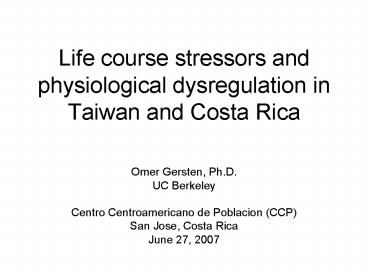Life course stressors and physiological dysregulation in Taiwan and Costa Rica - PowerPoint PPT Presentation
1 / 28
Title:
Life course stressors and physiological dysregulation in Taiwan and Costa Rica
Description:
Research question & hypothesis ... Data: 'Social Environment and Biomarkers of. Aging Study' (SEBAS) Strengths: ... the body's most immediate stress response ... – PowerPoint PPT presentation
Number of Views:48
Avg rating:3.0/5.0
Title: Life course stressors and physiological dysregulation in Taiwan and Costa Rica
1
Life course stressors and physiological
dysregulation in Taiwan and Costa Rica
- Omer Gersten, Ph.D.
- UC Berkeley
- Centro Centroamericano de Poblacion (CCP)
- San Jose, Costa Rica
- June 27, 2007
2
Outline
- Motivation (precise physiological mechanisms ---gt
- poor health)
- Background (stress concepts terms)
- 1st Taiwanese project (SEBAS)
- Costa Rican project (CRELES)
- SEBAS II/Future directions
3
Uncovering mechanisms of the "black box"
- Social connection --gt --gt Health
- Marriage Mortality
- Religious attendance Cardiovascular
disease - Other community participation Depression
- Number of friends
- Health consequences of similar magnitude as low
physical activity, obesity, and smoking - Longitudinal studies have accounted for health
status and personality characteristics
4
Social connection --gt Stress --gt Health
Change in cardiovascular activity (from baseline)
in response to mental arithmetic stress test,
with social support and without
5
Articles on allostasis and allostatic load
6
Allostatic theory defining homeostasis and
allostasis
- Homeostasis is the bodys equilibrium or ideal
steady-state - Allostasis refers to all the physiological
mechanisms that attempt to bring the body into
homeostasis - Allostatic mechanisms respond to all types of
challenges (i.e., physical, psychological, acute,
day to day)
7
Allostatic theory how allostatic mechanisms
extend the idea of homeostatic mechanisms
- Allostasis emphasizes normal operating ranges of
physiological parameters (e.g. different,
flexible setpoints in contrast to fixed
setpoints) - Allostasis emphasizes the role of the
brain/psyche in recognizing threats and
orchestrating holistic responses - Allostatic responses can learn from experience
and can anticipate and respond (in advance) to
challenges
8
Allostatic theory defining allostatic load (AL)
- AL represents cumulative wear and tear on the
body caused by activation of the allostatic
systems - AL accumulates over the life course and affects
multiple biological systems - Allostatic load (AL)
- Predisease indicator -----gt morbidity -----gt
mortality - (System dysregulation)
9
Research question hypothesis
- Are various indicators of life stress linked to
riskier neuroendocrine biomarker profiles? - Year 2000
- Earlier life history ---------------------------
--------gt Biomarker - collection
- Demographic
- low edu.
- minority status
- Social connectedness --------------------------
gt Higher AL - widowhood
- living alone
- Psychosocial stress
- subjective
10
Data Social Environment and Biomarkers of
Aging Study (SEBAS)
- Strengths
- Nationally representative survey
- (Taiwan, year 2000)
- Large (gt1000 respondents)
- Wide age range (54-91)
- High response rate (gt90 interview portion)
11
Data dependent variable
- Neuroendocrine allostatic load (NAL)
- Neuroendocrine markers represent the bodys most
immediate stress response - Survey measures resting, nonstressed levels
- Biomarkers Physiologic systems
- Epinephrine ----------gt Sympathetic nervous
system (SNS) - Norepinephrine
- Cortisol ----------------gt Hypothalamic-pituitary-
adrenal (HPA) axis - DHEAS
12
Distributions and cutpoints (10th or 90th
percentile)
13
Distribution of NAL scores (10th or 90th
percentile)
14
Distribution of NAL scores
15
Descriptive statistics (N 880)
16
Duration of various stressors (in years)
17
Regression results, women (NAL is the dependent
variable)
18
Regression results, men (NAL is the dependent
variable)
19
Additional analyses
- NAL a b1(years widowed)
- Including self-rated health in all regressions
does not change main results - Using cutpoints based on entire sample (i.e. men
women combined) or sex-specific cutpoints does
not change main results
20
Costa Rican Study on Longevity and Healthy
Aging (CRELES)
- Early life events
- early death of mother
- low edu. of mother
- live w/out biological father
- econ. problems (index) lt15 yrs. old
- health problems (index) lt15 yrs. old
- Loss
- death of children 2004-2006
- widowhood/years widowed --------------------gt
High NAL - Social deprivation
- low/no church attendance
- lives alone
- Spousal characteristics
- low edu.
- poor health
- Demographic
- low edu.
- poorer
- rural residence
21
Conclusions
- Q Are various indicators of life stress linked
to riskier neuroendocrine biomarker profiles? - A On the whole, no.
- But, we need to better measure respondents
stress over the life course and neuroendocrine
biomarkers
22
SEBAS II (2006)
- Added stress related questions
- Daily hassles (e.g. argument w/anyone since
yesterday) - Major life events (e.g. job change, major
illness, death of family member) in past year - Traumas (e.g. being beaten, homicide or suicide
of family member) at any time in ones life - Perceived stress (e.g. difficulty coping with
events, feelings of loss of control) in past
month - Security-related (e.g. feeling safe in
neighborhood) and caregiving stress
23
Future possible improvements in the SEBAS
- Multiple measures of urinary samples (e.g. 3
overnight urinary samples over 2 weeks and/or
daily and nightly urinary samples) - A measure of cortisols diurnal rhythm (e.g. 5
salivary cortisol samples over the day)
24
Cortisols diurnal rhythm younger older
persons
25
Future possible improvements in the SEBAS
- Multiple measures of urinary samples (e.g. 3
overnight urinary samples over 2 weeks and/or
daily and nightly urinary samples) - A measure of cortisols diurnal rhythm (e.g. 5
salivary cortisol samples over the day) - A measure of reactivity (e.g. stress test
w/attention to speedy return to baseline levels)
26
(No Transcript)
27
- Fin
- Muchas gracias!
28
Recommended biomarkers across different
physiological systems to test AL
First used to operationalize AL (in the
MacArthur studies)































